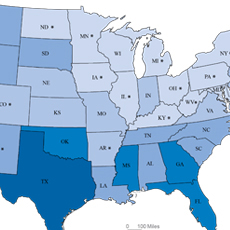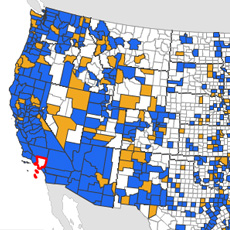Census.gov > Library > Infographics & Visualizations > 2012 > Before and After 1940: Change in Population Density
Library
Before and After 1940: Change in Population Density
August 16, 2012

County-level population change for the 1930s differed from the 1920s or the 1940s, as shown in this set of three maps. In the 1920s, a number of predominantly rural counties in the nation's eastern half saw declines in population and population density, often reflecting outmigration to cities. During the 1930-1940 decade the pattern reversed, with population and population density declines primarily located in the Great Plains. Between 1935 and 1940, 12 percent of the population moved to another county or state. This represented a lull in population movement that changed during and after WWII as geographic mobility increased in the U.S. For instance, between 1940 and 1947, 21.5 percent of civilians moved to different counties or states. In the 1940-1950 period, population density increased for the more urban and populous counties in the Northeast and Midwest, but declines were widespread in predominantly rural counties.
SOURCE: Maps are based on decennial census data 1930 to 1950. National migration figures quoted in the text are from the 1940 decennial census and the 1947 Current Population Survey.
NOTE: County boundaries are based on 2010 geography, to ensure comparability between decades. For counties in which there have been changes in extent between 1920 and 2010, decennial census data are used as the basis for estimates of historical populations. Data values were rounded to the nearest whole number before classing.
Recent Data Visualizations
 Population Without Health Insurance
Population Without Health Insurance Population Bracketology
Population Bracketology Measuring Race and Ethnicity Across the Decades: 1790-2010
Measuring Race and Ethnicity Across the Decades: 1790-2010  Where do college graduates work?
Where do college graduates work? Story Maps Illustrate Population Change
Story Maps Illustrate Population Change HIV/AIDS Impact in Africa
HIV/AIDS Impact in Africa Distribution of Hispanic or Latino Population by Specific Origin: 2010
Distribution of Hispanic or Latino Population by Specific Origin: 2010 A Century of Population Change in the Age and Sex Composition of the Nation
A Century of Population Change in the Age and Sex Composition of the Nation  Shifting Occupational Shares
Shifting Occupational Shares Metro Area Density
Metro Area Density Work-Life Earnings
Work-Life Earnings Census Flows Mapper
Census Flows Mapper Migration Between Calif. & Other States
Migration Between Calif. & Other States U.S. Territory and Statehood Status
U.S. Territory and Statehood Status Spoken Languages Other than English
Spoken Languages Other than English Center of Population, 1790-2010
Center of Population, 1790-2010 Population Change by Decade
Population Change by Decade Without A High School Education
Without A High School Education A Decade of State Population Change
A Decade of State Population Change State-to-State Migration for States of 8 Million or More
State-to-State Migration for States of 8 Million or More Population Under 5 Years Old by Congressional District
Population Under 5 Years Old by Congressional District Components of Metro Area Change
Components of Metro Area Change Blooming States
Blooming States Coastline County Population
Coastline County Population Coastline County Population
Coastline County Population I-90 Population Density Profile, 2010
I-90 Population Density Profile, 2010 Second Cities: Keeping Pace with a Booming New York
Second Cities: Keeping Pace with a Booming New York By the Grid: Population Shift to the West and South
By the Grid: Population Shift to the West and South I-10 Population Density Profile, 2010
I-10 Population Density Profile, 2010 Booming Cities Decade-to-Decade, 1830-2010
Booming Cities Decade-to-Decade, 1830-2010 I-5 Population Density Profile, 2010
I-5 Population Density Profile, 2010 Islands of High Income
Islands of High Income The Great Migration, 1910 to 1970
The Great Migration, 1910 to 1970 Following the Frontier Line, 1790 to 1890
Following the Frontier Line, 1790 to 1890 Changing Ranks of States by Congressional Representation
Changing Ranks of States by Congressional Representation Cartograms of State Populations in 1890, 1950, and 2010
Cartograms of State Populations in 1890, 1950, and 2010 Before and After 1940: Change in Population Density
Before and After 1940: Change in Population Density From Physical to Political Geography
From Physical to Political Geography Differential City Growth Patterns
Differential City Growth Patterns I-95 Population Density Profile
I-95 Population Density Profile Increasing Urbanization
Increasing Urbanization Gaining and Losing Shares
Gaining and Losing Shares Top 20 Cities
Top 20 Cities




